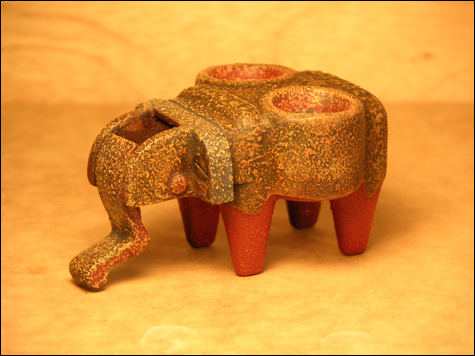
UNTITLED: Mixed-media found objects, by Jesse Gillespie. |
| “Tiny” | at Whitney Art Works, 490 Congress St, Portland | through Dec 22 (closed Thanksgiving week) | Wed-Sat noon- 6 pm | Reception 5-8 pm Dec 7 |
The “Tiny” show at Whitney Art Works is a big group show of very small works. There are more than 80 artists represented by 200-plus works, a big show by any measure. Most of the works are no more than eight inches in any dimension. As densely populated as this show is, its mood is orderly, even tranquil.The quality of the work is consistently pretty high, which is unusual for a show as with as many works as this one. The uniform consistency is a result of curatorial work done by Bruce Brown, who came up with the idea for the show and chose the artists. Brown is the former curator of the Maine Center for Contemporary Art in Rockport, and did that same job when it was just Maine Coast Artists. He has had a catalytic role in Maine art for upwards of 30 years, as a curator, collector, educator, and interested spectator. Brown is probably the only person in Maine who knows enough artists and their work to actually attempt a show like this, let alone have the eye to make a good show out of it.
There are paintings, drawings, photographs, minimalist sculptures, conceptual pieces with a Fluxus tinge, multiples, a standing figure sculpture, digital prints, a video installation, and even some buttons. Brown has surveyed the ground pretty thoroughly.
Many of the works are small enough to call to mind the portrait miniatures so popular in the 18th century, or perhaps illustrations in medieval illuminated manuscripts, and like those, each needs to looked at carefully. There’s no middle ground; either look at them closely or you don’t see much at all. There’s plenty to enjoy here but the process takes some time. It seems the smaller the piece, the longer you need to look at it.
These days we are accustomed to encountering large objects in art galleries. Works compete to command our view, occupying all or nearly all of our visual field. We tend to walk through galleries quickly, sizing up the gestalt of a solo or group show and moving on. We are expected to see the work in terms of its contemporary social or historical context, as part of an ongoing public theoretical discourse.
The nature of this show, and of the works that comprise it, requires that we approach our task as viewers differently. Looking at an object that can be held in one hand produces a feeling of intimate relationship to it, invoking a personal sense of focus that seems to exclude the work’s surroundings. A very small object can seem monumental in scale as it expands the mind’s eye. The littlest details become important. Things get distilled down to their essentials.
We can see this distillation in, for instance, the work of Lois Dodd, one of the most widely known of the artists. Her four paintings are each no more than five or six inches square, but they are instantly recognizable as hers. What is it about her work that is so distinct that it can be clearly represented in so small an image? Whatever it is, it’s more than mere style and it’s clearly present in these little paintings.